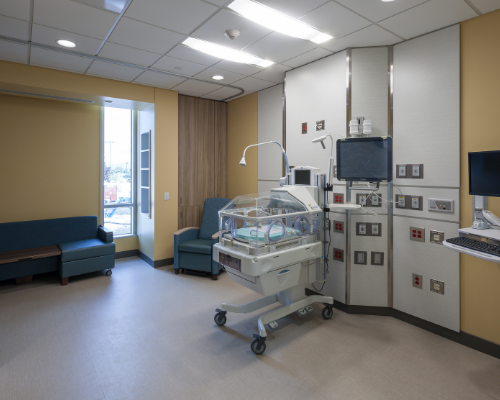Our NICU
Logan Health Children’s level III NICU offers the highest level of neonatal care in Montana. Families come to Logan Health Children’s because our providers are among the best in the region. Every staff member are dedicated caregivers who are here for your whole family.
Care Beyond the NICU
If you deliver at Logan Health Medical Center, you are just down the hall from your baby so you both can recover near each other under some of the best care in the state. We also coordinate closely with many of our pediatric specialists in cardiology, endocrinology, gastroenterology, pediatric sugery and many other areas if your baby needs specialized care.
You can rest assured that your baby is being cared for by a highly experienced team of providers and caregivers. When you come into a a NICU like ours, you’re surrounded by an entire team network of caregivers who specialize in caring just for kids.
Conditions We Treat
 Babies whose primary diagnosis is prematurity and just need some extra time in the hospital to grow and develop are cared for by Logan Health Children’s neonatologists in the NICUs. Sometimes, newborns and premature babies with complex medical and surgical conditions need to be treated in the NICU for various and sometimes rare and complex conditions. Some of these conditions include:
Babies whose primary diagnosis is prematurity and just need some extra time in the hospital to grow and develop are cared for by Logan Health Children’s neonatologists in the NICUs. Sometimes, newborns and premature babies with complex medical and surgical conditions need to be treated in the NICU for various and sometimes rare and complex conditions. Some of these conditions include:
- Neonatal breathing conditions: Neonatal respiratory conditions can arise for several reasons: delayed adaptation or maladaptation to extra-uterine life, existing conditions such as surgical or congenital anomalies or from acquired conditions such as pulmonary infections occurring either pre- or post-delivery.
- Neurological conditions: A newborn baby can present with a variety of neurological problems that stem from conditions that affect his brain, spinal cord, peripheral nerves, and muscles. There are more than 600 neurological disorders that can occur throughout a person’s lifetime, but fewer neurological conditions occur in newborns. These disorders can be present at birth or happen shortly after birth. The foundation for development of your baby’s brain starts in the first month after conception. The brain continues to develop throughout pregnancy and after birth. Any disruption or injury to the brain development during this period can lead to neurological problems.
- Digestive conditions: A newborn’s ability to eat and digest food is essential to growth and development. Most babies are able to take feedings with normal absorption of the milk followed by normal bowel movements. Difficulty in any of these areas can be a temporary adjustment or a sign of a more serious problem.
Infant Safe Sleep
Safe sleep can help protect your baby from sudden infant death syndrome (SIDS) and other dangers.
Why practice safe sleep?
- The highest risk period of SIDS is between one month and four months of age, but can occur up to one year of age.
- The side lying or stomach position increases the risk of the infant rebreathing their own exhaled breath. This could cause the infant to breathe in more carbon dioxide than oxygen. Without a proper response from the infant, this could lead to death.
- Bed-sharing increases the risk of SIDS threefold and smoking increases the risk of SIDS sixfold.
- Infants are actually more likely to choke or aspirate when lying on their stomachs.
What is a safe sleep environment?
- Place the baby on their back for every sleep.
- Use a firm sleep surface with only a tight fitted sheet. The risk of SIDS increases fivefold with the use of soft bedding.
- No loose bedding, blankets, bumpers, or stuffed animals in the sleeping area. Decorate the room, not the bed. With current crib safety standards, bumper pads are unnecessary.
- Use a wearable blanket or sleeper onesie to keep the baby warm. Blankets are no longer recommended and the use of a sleep sack is preferred over a blanket to decrease the risk of a blanket covering the infant’s head or face.
- The American Academy of Pediatrics recommends avoiding hats or head coverings when the baby is sleeping.
- Infants should sleep in the same room, but not in the same bed as the parents for at least the first six months. This can decrease the risk of SIDS by 50 percent.
- Put baby in the crib for sleeping. The risk of SIDS for an infant sleeping on a couch with someone increases 50 times due to suffocation risk.
- Keep the room at a comfortable temperature and avoid overheating the infant. As a general rule, dress the infant in one additional layer from what an adult is comfortable in.
- If a pacifier is used, it should not have any strings, tethers, or stuffed animals attached.
- Maintain a smoke-free sleeping environment.
Additional ways to decrease the risk of SIDS:
- Breastfeeding is associated with a decrease in the risk of SIDS.
- Twenty percent of SIDS deaths occur while in the care of a childcare provider, so it’s important to tell anyone and everyone that takes care of your baby what the latest safe sleep practices are.
- Teach siblings about safe sleep practices.
- Avoid smoke exposure during pregnancy and after birth. There is not only firsthand and secondhand smoke to worry about, but also thirdhand smoke, which can take at least three washes to remove particles from clothing, hair, and furniture.
- Avoid alcohol and illicit drug use during pregnancy and after birth.
- After breastfeeding is established, offer a pacifier at naptime and bedtime.
- Provide supervised, awake tummy time to promote development.
Resources
Meet Our Team

